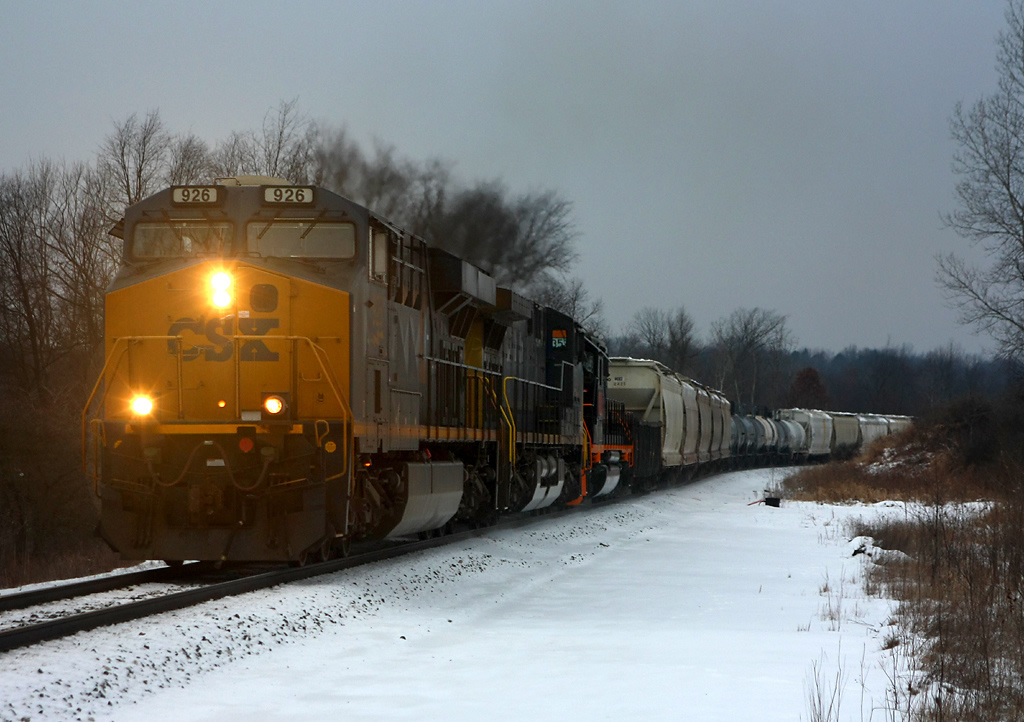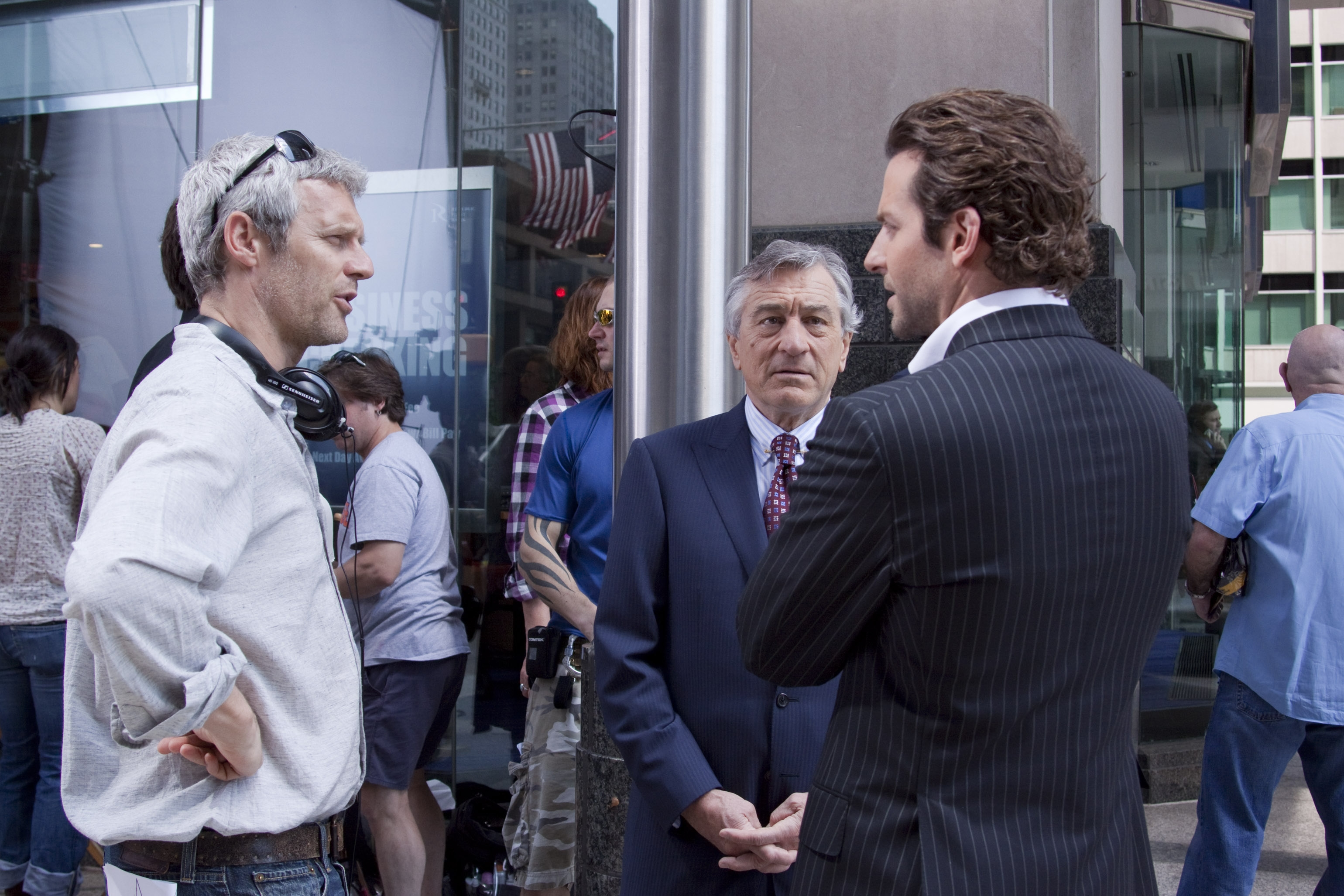
(c) 2011 Dark Fields Production, LLC
Each week, people flock to their local movie theaters to experience the magic of the movies. Movies let the audience escape to far off places and experience the joys and struggles of the human population. One locale being used more and more frequently is Pennsylvania. Pennsylvania is known for many things: steel, coal, railroads, the Amish, the toughest sports fans in the nation, and two sprawling metropolises, Philadelphia and Pittsburgh. If you want to experience all that Pennsylvania has to offer, you only need to “take a seat and enjoy the film.” Since the 1950s, movies filmed in Pennsylvania have captured the unique characteristics that set the Keystone State apart. From horror films to dramas, Pennsylvania films have something to offer everyone.
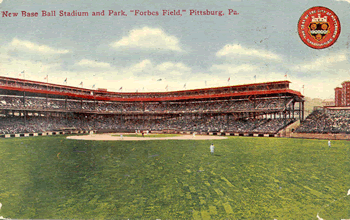
Philadelphia and Pittsburgh have some of the toughest and most dedicated sports fans in the nation, and they enjoy seeing their passion on the silver screen. America’s greatest past time, baseball, made its Hollywood debut when director Clarence Brown chose to use one of the National League’s first modern concrete-and-steel parks, Forbes Field, to shoot Angels in the Outfield. Forbes Field towered above a picturesque city park making for a beautiful backdrop for the film. Angels in the Outfield became one of the first in a long list of feature films to be shot in Pittsburgh. The film focuses on the Pittsburgh Pirates and their race to the pennant. At the beginning of the film, the Pirates were in last place, which coincidentally reflected the team’s real life situation. In 1950, with a record of 57-96, the Pirates finished in last place in the National League standings. However, the Pirates’ dismal record did not stop major league talent from getting in on the action. Have you heard of Ty Cobb and Joe DiMaggio, but were too young to see them in their prime? Well don’t worry because both legendary players make appearances in the movie and fans receive a rare glimpse of the players off the field. Viewers may also catch a peek of then co-owner of the Pirates, Bing Crosby, playing golf in one scene. Most baseball fans today did not have the opportunity to see Forbes Field because it was damaged by two fires and then demolished in 1971, but it will forever be immortalized on film thanks to Angels in the Outfield.
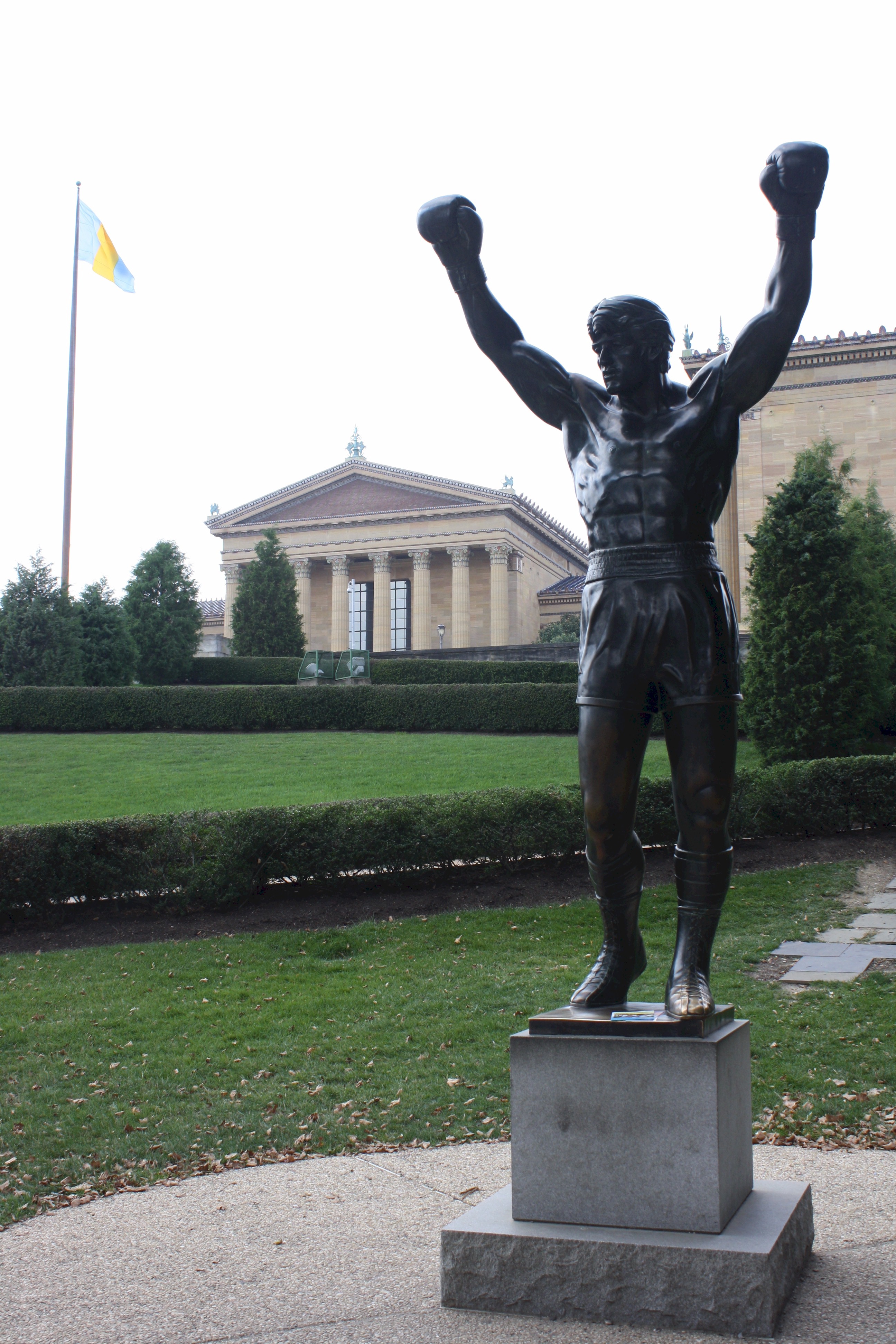
“Cut me, Mick”… One of the most well known and memorable sports films is the 1976 phenomenon Rocky starring Sylvester Stallone. The movie is about a struggling boxer who works in a Philadelphia meat plant and gets the once-in-a-lifetime chance to fight the heavyweight champion. This movie was filmed away from the historic section of the city and instead gave viewers a look at north Philadelphia’s gritty Kensington Section. The world was also introduced to the “Philly Cheesesteak.” Pat’s King of Steaks, located in South Philadelphia made an appearance in the film. The popular eatery commemorated this moment with a plaque that reads “On this spot, in front of Pat’s King of Steaks, on November 21, 1976, stood Sylvester Stallone filming the great motion picture Rocky.”
The Rocky Franchise also left Philadelphia with one of its most visited attractions, the “Rocky Statue.” Director/writer/actor Sylvester Stallone commissioned the statue as part of Rocky III, which was released in 1982. During filming, the statue stood atop the steps of the Philadelphia Museum of Art overlooking the Benjamin Franklin Parkway. After filming, Stallone donated the statue to the city and requested that it remain in its location atop the Art Museum Steps. Many did not feel the location was appropriate and the statue was eventually moved to the Wachovia Spectrum. In 2006, the statue found a permanent home at the foot of Eakins Oval next to the steps of the Philadelphia Museum of Art. Not only did the statue make an appearance in Rocky III and Rocky V, but it can be seen in films such as Trading Places with Eddie Murphy, Mannequin with Andrew McCarthy and Philadelphia with Tom Hanks. When fans blast Survivor’s “Eye of the Tiger” from their iPods as they dash up the Art Museum steps reenacting the famous scene, they can literally step in Rocky’s shoes. Atop the steps, bronze foot prints commemorate the spot where Rocky fist-pumps after his training. To fuel your passion for Pennsylvania sports in the offseason, check out: That Championship Season, Stealing Home, Invincible, Rocky Balboa, The Greek American, and Slap Shot.
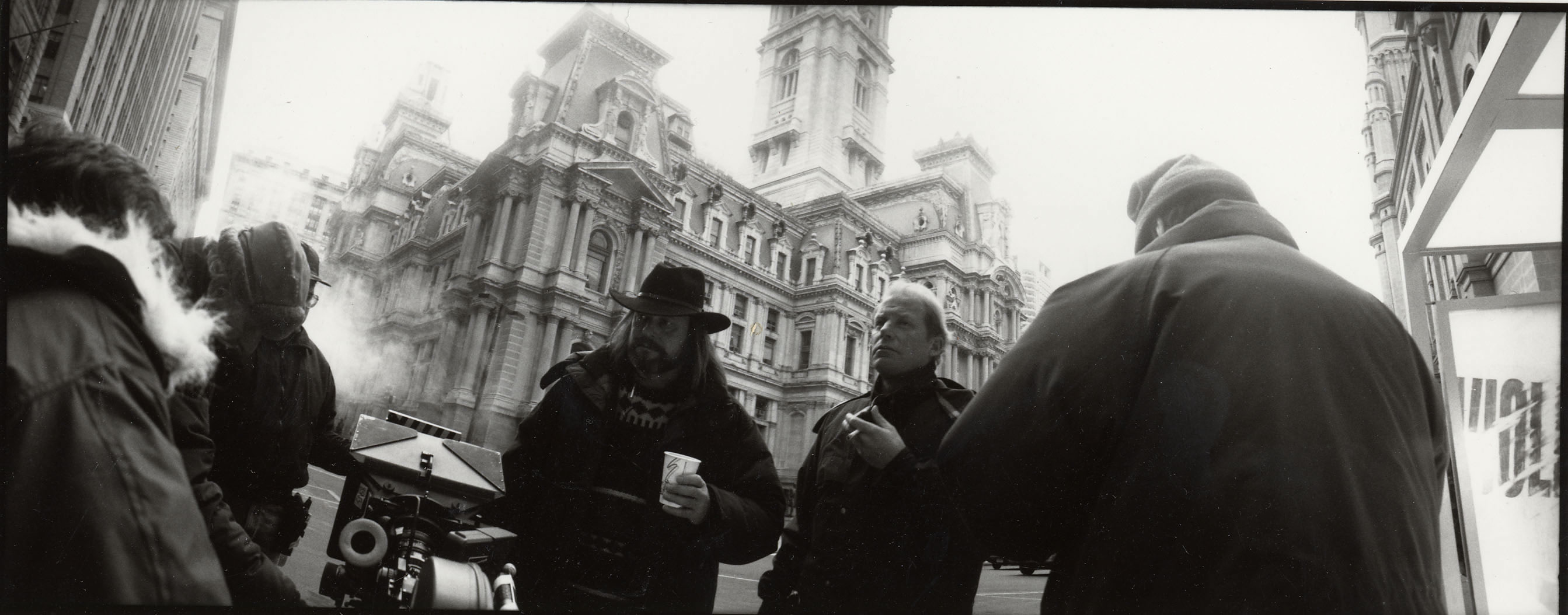
Hollywood producers are drawn to Pennsylvania to create startlingly real portrayals of the hardworking people who keep this country growing. Once the fuel choice of transportation and an essential element in steel production, coal was a vital part of the of the state’s economy. The 1970 film The Molly Maguires not only depicted the struggles of exploited coal workers in the anthracite coal regions, but also saved the town of Eckley from demolition, according to historian William Kashatus. After the decline of the anthracite coal industry during the 1920s and 50s, Eckley’s population had fallen to 500 and the demolition of Eckley seemed eminent. Fate led the property’s owner George Huss to lease the village to Paramount Pictures for the filming of the The Molly Maguires. This location was perfect for the film since the town had remained practically unchanged and retained a 19th century appearance. The production company removed telephone poles, had underground wires installed and camouflaged the main street with coal slag. Paramount also added a company store and converted the Eckley Sports Club into the Emerald House Saloon. During production, the Anthracite Historic Site and Museum Corporation raised $100,000 and purchased the town from Huss. Then, in 1970, on the day the film premiered in a nearby Hazleton theater, the corporation presented Eckley to the Commonwealth of Pennsylvania. In 1975, the Pennsylvania Historical and Museum Commission opened Eckley’s Miners’ Village, which continues to serve as a open-air museum preserving the history of the anthracite industry.
Michael Cimino’s 1978 Academy Award-winning drama The Deer Hunter is hailed as one of the best depictions of the terrible effects of war on the psyche of the American solider. The film chronicles the struggles of Pennsylvania steel workers before, during, and after the Vietnam War. The men work in the blue-collar town of Clairton, about ten miles south of Pittsburgh; however in the film, Clairton is actually a mixture of eight different. Three locations are in Pennsylvania: the real Clairton, McKeesport, and Pittsburgh. Nestled between the Ohio River and Pennsylvania, Weirton and Follansbee, West Virginia, were used as well. The other three locations lie to the west in Ohio. Cimino chose to use Steubenville, Mingo Junction, and Struthers to capture the home lives of his characters. At the end of the film, Christopher Walken’s character is buried in the Pennsylvania Versailles Cemetery in McKeesport. The beauty of this film is how it portrays the culture of steel towns and the daily hardships the residents face. The men are seen living simple lives as best they can. Besides viewing the workers daily grind of going to work and stopping by the local bar after their shift, the audience sees how their community celebrates the special milestone of marriage in a place where there are few opportunities to rejoice.
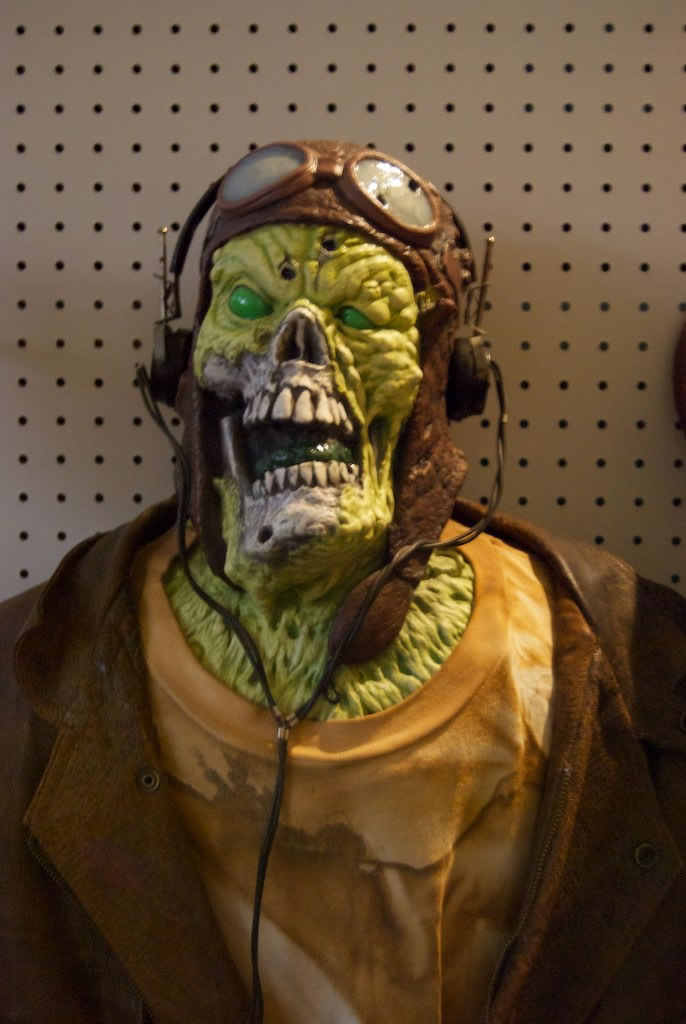
Pennsylvania also has a flair for the undead. George Romero, a Carnegie Mellon graduate, filmed his low-budget independent 1968 film Night of the Living Dead in the Pittsburgh area. The opening scenes of the graphically gruesome zombie movie were shot in Evans City Cemetery. The locations and real headstones can still be scene today and make for an interesting field trip. Romero then shot the sequel Dawn of the Dead in the Monroeville Mall during the winter of 1976-77. Filming began at the mall around 10 p.m. after the mall closed and ended at 6 a.m. Although much of the mall has been changed since the filming, the J.C. Penney’s department store, which was featured heavily in the film, remains. Thanks to the movie, Pennsylvania can also brag that it holds the Guinness World Record for the largest Zombie Walk which takes place annually at the Monroeville Mall.
In 1990, Romero also filmed the horror flick The Dark Half in Pennsylvania, even though it was set in Maine. “I don’t put it in the contract that I have to shoot here. But a lot of people in the business have discovered it’s a great place to shoot,” explains Romero. Fans admired Romero and said, “He was approachable. He talked to the fans. He seemed to have a genuine hometown feel for the community. And he preferred to stretch out in the sun on a leaf-filled lawn during breaks rather than escape to a van or a secluded restaurant for lunch.” When the production crew packed their trucks and pulled out, there was a definite letdown. As residents explained it, George had brought a, “once-in-a-lifetime thing to our doorstep. We would always be grateful to the man.” Other horror flicks filmed in PA include: Creepshow, The Mothman Prophecies, Bloodsucking Pharaohs in Pittsburgh, and Monkey Shines.
Lancaster County and the Amish hit the silver screen in 1985’s Witness, starring Harrison Ford. Ford plays a detective who is charged with protecting a young Amish boy who witnesses a murder in Philadelphia while traveling with his mother. With the killers searching for the boy, Ford retreats into the Amish country side with the family. The murder scene was shot in 30th Street Railway station. Location director Mike Meehan said they were after a “working-class, urban look,” a nighttime world of violence and decay to contrast with the beautiful country scenes in Lancaster. “Philadelphia was mentioned in the script, so we decided to come and see if the movie could actually be shot here. The city looked great in Trading Places, but we didn’t know if we’d be able to get the kind of access we’d need.”
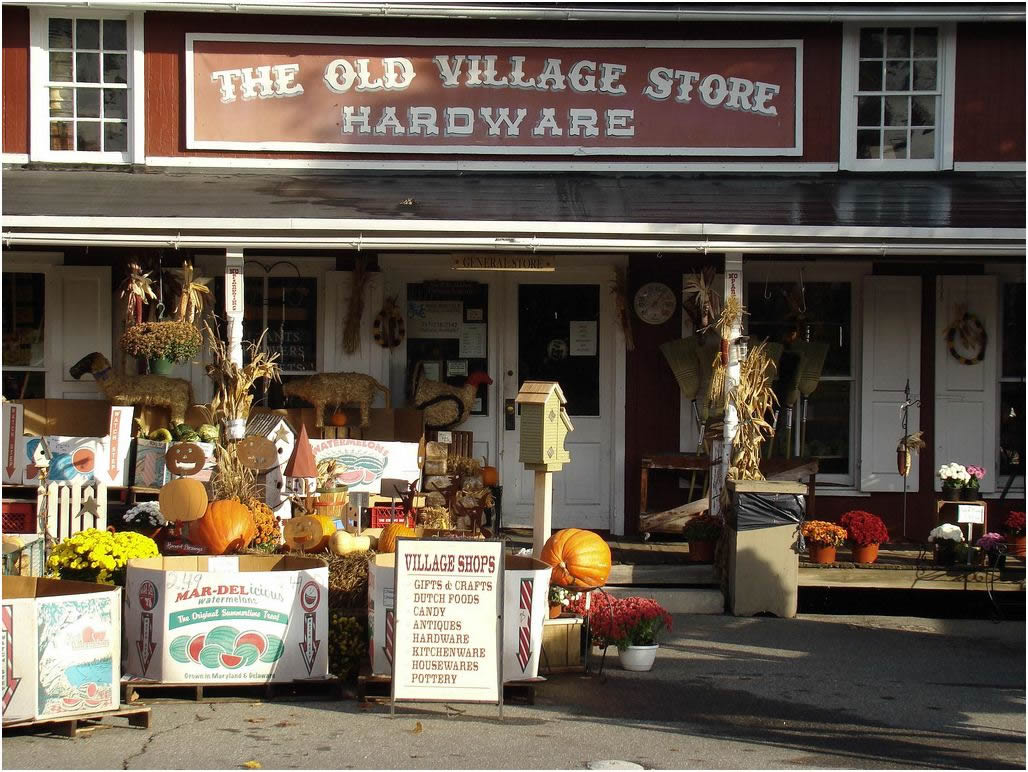
The biggest difference between shooting a movie in Philadelphia and shooting in Hollywood, Meehan said, “is that when you shoot a movie here everybody gets real excited about it.” Producer Ed Feldman had only good things to say about the city as well. Feldman was quoted, “I want to say that shooting here in Philadelphia has been absolutely terrific. For one thing, Pennsylvania has a tremendous film commission. And Philadelphia, well, I can’t say enough. They’ve made it very easy for us to come here. Really. There hasn’t been a single problem.” They even made it easy for Harrison Ford to travel to the city to study the techniques of homicide investigators for the role. Ford traveled to Norristown, Montgomery County to witness detectives arrest a murder suspect.
As with many films, Witness provided work for locals. “The company I worked for was going out of business, so I went to the Teamsters union hall and they told me there was an opening for a movie and they signed me up. I was there for three months. It paid really well,” said one Lancaster County native. Bob Lawrence, 58, who was a city policeman in 1983, worked security at the Strasburg-area farm where much of the movie was filmed. Paramount Pictures hired city police to do almost all of the security for the film on an overtime basis. Lawrence says Ford was the nicest guy in the world and liked hanging out with cops or hanging out in the woodshop on the farm. “He was just a regular guy,” Lawrence remembers.
Conceivably the biggest supporter of using Pennsylvania as a backdrop is M. Night Shyamalan. Shyamalan grew up in Penn Valley and returned to the area to film his suspense-filled, plot twisting blockbusters. Shyamalan first received praise for his genius after filming The Sixth Sense starring Bruce Willis in Philadelphia in 1999. He chose the city for his next film Unbreakable and then chose to head to the farmlands of Bucks County to shoot his next three feature films: Signs, The Village, and The Happening. Through his works, Shyamalan has shown the world the beauty of Pennsylvania and the marvels hidden in the country side. Shyamalan also formed his own production company, Blinding Edge Pictures, and chose Berwyn as its headquarters.
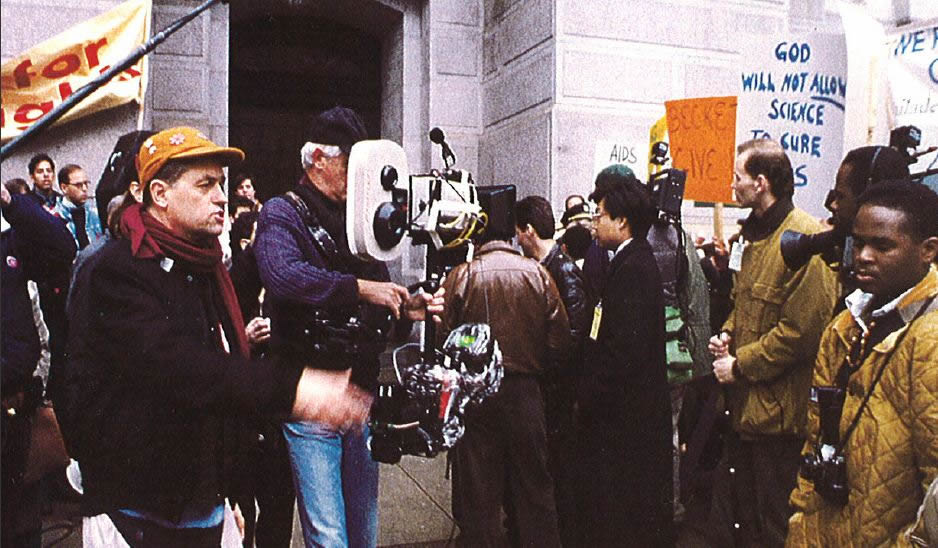
It’s a good thing Shyamalan chose Bucks County because it is an incredibly diverse and beautiful area to use in film and has since been featured in many pictures. The area’s charm lays in the way the region seamlessly blends historic landmarks, picturesque old time homes, working farms, and sprawling hills with modern communities. Bucks County became the set for scenes from 2009’s Law Abiding Citizen. Jamie Foxx stars as an assistant DA who finds himself at the mercy of a spiteful vigilante, Gerard Butler, hell-bent on avenging the death of his wife and daughter, whose murderers are set free due to legal loopholes. The production crew took over a farm in serene Farmville, PA, for three days to shoot scenes of Gerard Butler’s home. “The police were raiding the place; running, shooting,” Anna Simons, who lives on a nearby farm on Holicong Road, said of the scene she witnessed. “I saw a helicopter hovering over the field, with a cop hanging out with a gun ... it was fascinating,” she said. “You could see the other helicopter with the camera filming. They were so low you could talk to them.” Anna Simons’ response is like the many other ordinary Pennsylvanians who experience the intensity of movie production. This film also gives viewers an extensive inside look at the now closed Holmesburg Prison. The landmark was created in 1896 and was closed in 1995. Tours are still given, but who needs to travel when they can see amazing aerial an inside shots in this thrilling film. Speaking of visiting historic landmarks, have you ever wanted to visit City Hall in Philadelphia? Well there’s no need to even leave your couch because you can follow Jamie Foxx throughout the building and see the beautiful, gold gilded court rooms and back work rooms used by lawyers to do research.
Potter Township, Beaver County got its taste for Hollywood as well in 2009. Unstoppable, starring Denzel Washington and Chris Pine, is about a half-mile-long runaway train with toxic cargo that threatens to destroy a city. Director Tony Scott chose to use the Horsehead Corp. plant in Potter Township to shoot a scene and about 20-25 plant employees were able to play extras in the film. The scene in Potter Township is one of the earliest scenes in the film and other locations include Cameron County, Tyrone in Blair County and under the 31st street bridge in Pittsburgh’s Strip district. Local students were given the chance to work as production assistant on the set. Alyson Cohen, a journalism Major at Penn State describes her experience: “I was really surprised to see that a $200 million movie was going to be filmed in the Central PA area. I know that the film industry gets a tax break in certain states like Pennsylvania and Michigan, but I was unaware of how many movies are currently being filmed on location in cities like Pittsburgh. This tax break allows production companies like 20th Century Fox to have a high budget for several movies, knowing that they will get money back besides the gross amount of box office ticket sales. Working as a production assistant on the movie set for Unstoppable was a great experience for me. I not only learned the lingo of film industry, but I got to see first hand how many people it takes to make a movie before post production. It is unbelievable to see how much $200 million can buy you on a movie set, especially when the economy is in a downward spiral.”
The tax break Cohen speaks of is the Film Production Tax Credit. In 2007, in an effort to increase use of Pennsylvania as a production site, Governor Edward G. Rendell and the PA legislature increased the Commonwealth’s film production incentive program (Government Incentives). Pennsylvania now provides a 25% Film Production Tax Credit for film production expenses incurred in the Commonwealth. This credit is available for feature films, TV shows and series, and commercials intended for a nation audience. The state requires that 60% of the total production expenses be incurred in PA and in the 2010 cap is set at $42 million (Government Incentives).
Pennsylvania is a great place to visit, but who needs to get on a plane when they can travel to their local video store? The film industry has done a remarkable job capturing the essence of the keystone state, and with the legislature’s tax credit, we can be sure that PA will be the location of many films to come.
The Center would like to thank Ryan Callahan of the Greater Philadelphia Film Office for his help illustrating this article.
Sources:
- “Angels in the Outfield (1951).” The Internet Movie Database (IMDb). Amazon.com. 1 Mar. 2010 <http://www.imdb.com/title/tt0043286/>.
- Budinger, David. “HOORAY FOR HOLLYWOOD, BUT I REALLY DO HAVE A LOT OF WORK TO DO.” Pittsburgh Post-Gazette 18 Nov. 1990, Regional sec.: W2. Print.
- “Dawn of the Dead.” The Flesh Farm. Ed. J.P. Butche. 1 Mar. 2010 <http://www.thefleshfarm.com/dawnofthedead/dawnofthedead.htm>.
- Doherty, Robert. “PENNA. MAKING ALL THE RIGHT MOVES FOR HOLLYWOOD.” The Philadelphia Inquirer 15 Sept. 1983, Final ed., Local sec.: B16.
- Erickson, H. “George Romero.” The New York Times 1 Mar. 2010 <http://movies.nytimes.com/person/108784/George-Romero?scp=1&sq=George%20....
- “Film locations for The Deer Hunter (1978).” The Worldwide Guide to Movie Locations. 1 Mar. 2010 <http://www.movie-locations.com/movies/d/deerhunter.html>.
- Fritsky, Lauren. “Captive Audience.” The Northeast Times [Philadelphia] 3 Aug. 2006.
- “Government Incentives.” The Pittsburgh Film Office. 1 Mar. 2010 <http://www.pghfilm.org/incentives.jsp>.
- Holahan, Jane. “20 years later, ‘Witness’ still captivates county.” Lancaster New Era 12 Apr. 2005, Local News sec.: B-1.
- Kashatus, William C. “THE MOLLY MAGUIRES.” Citizen’s Voice [Wilkes-Barre] 12 May 2008, Valley History sec.
- Lyman, Rick. “FILM FOLK ARE MADE TO FEEL AT HOME IN PHILA.” The Philadelphia Inquirer 11 May 1984, Final ed., Feature People Home Entertainment sec.: D01.
- “M. Night Shyamalan Biography.” Yahoo! Movies. 1 Mar. 2010 <http://movies.yahoo.com/movie/contributor/1800019667/bio>.
- Mervis, Scott. “ZOMBIES ARE CRAWLING, TOO.” Pittsburgh Post-Gazette 16 July 2009, ARTS & ENTERTAINMENT sec.: W-16.
- Nale, Mark. “‘Unstoppable ‘urge.” The Centre Daily Times [State College, PA] 15 Nov. 2009: 8.
- “Rocky (1976).” The Internet Movie Database (IMDb). Amazon.com. 1 Mar. 2010 <http://www.imdb.com/title/tt0075148/>.
- Savana, Freda R. “Lights, camera, action in Bucks.” Bucks County Courier Times [Levittown] 24 Mar. 2009, Local sec.: 1.
- Tady, Scott. “GetOut - ZOMBIE HOLIDAY PARTY MONROEVILLE MALL.” Allegheny Times 11 Dec. 2009, Coraopolis, PA ed.: B3.
- Templeton, David. “DISTRICT IN THE PICTURE FOR MORE FILMMAKING.” The Pittsburgh Post-Gazette 2 Dec. 1990, Regional sec.: W1.
- Terry, Robert J. “Detectives Show Actor the Ropes.” The Philadelphia Inquirer 2 Mar. 1984: B03.
- The Associated Press. “100 years ago, Forbes Field was MLB’s first palace.” Pittsburgh Tribune-Review 20 June 2009.
- Vitez, Michael. “Rocky Statue History and Ongoing Influence.” About.com. New York Times Company. 1 Mar. 2010 <http://philadelphia.about.com/od/uniquelyphiladelphia/l/blrocky_statue.htm>.
- Wheeler, J. “Law Abiding Citizen | Movie | Moviefone.com.” Moviefone. AOL.com. 1 Mar. 2010 <http://www.moviefone.com/movie/law-abiding-citizen/36929/main?icid=movsm....
- Winks, Michael. “ROMERO KICKS OFF STAR-STUDDED ‘DARK HALF ‘HERE.” The Pittsburgh Post-Gazette 22 Oct. 1990, Entertainment sec.: C2.
- “Witness Movie Filming Locations.” The 80s Movies Rewind: Home of ‘80s Retro Movies. 1 Mar. 2010 <http://www.fast-rewind.com/locations_witness.htm>.

